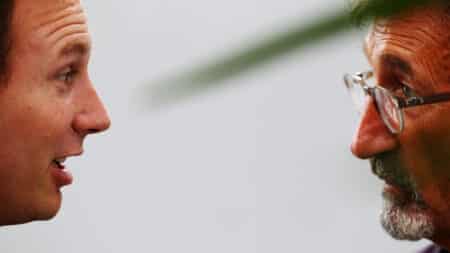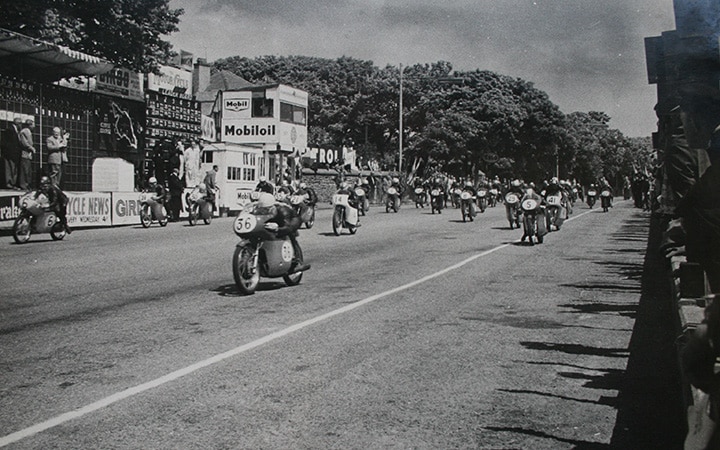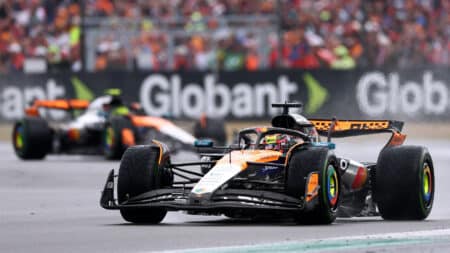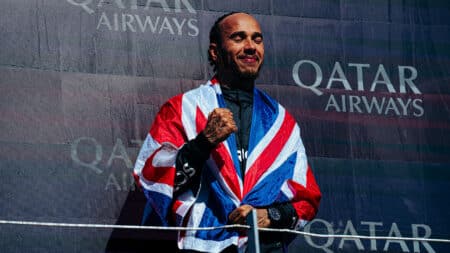
Horner's departure shows age of the maverick F1 boss is over
Christian Horner has now left Red Bull, the last of a certain breed of F1 team principal

The 1959 125cc TT start: Naomi Taniguchi (8) is mid-pack
When Marc Márquez swept to Honda’s 700th Grand Prix victory on Sunday he did so at the head of the factory Repsol Honda team, probably the biggest outfit in the paddock, with every member trained and drilled to deal with every eventuality.
It is a somewhat different set-up to the brave little crew that turned up for the company’s first world championship race, the Isle of Man TT in June 1959.
In the 1950s the Isle of Man wasn’t on a different planet from Japan, but it may as well have been. This was a journey entirely into the unknown. Honda’s GP vanguard had no idea what to expect from the track, the people, the food, the culture or the country; after all, this was less than 15 years after the end of World War II. They were innocent of everything, so it was a journey that would be impossible to undertake today, unless you’re an Amazonian Indian.

Team leader Yoshitaka Iida and top finisher Naomi Taniguchi, with TT replica, in Tokyo
Honda’s nine staff – including five riders, who did double duty as mechanics – flew to the Isle of Man from Tokyo, via Hong Kong, Bangkok, Calcutta, Karachi, Beirut, Frankfurt and London. They flew most of the way in a BOAC Comet, the world’s first commercial jetliner.
During the previous months they had spent their time learning how to eat with a knife and fork, how to wear a suit and tie, instead of traditional Japanese dress, and also mourning the death of a team-mate, who had died while doing stunts for a Japanese biker movie. All these men were members of the Honda Speed Club, a gang of keen young Honda employees who raced and did movie stunts on Hondas.
They had also spent plenty of time trying to memorise a TT course guide written by 1950s TT legend Geoff Duke and translated into Japanese by their recently deceased team-mate. Only when they arrived at their Island hotel did they realise the horrible truth: they had been learning the wrong track. For a few years in the late 1950s the usual 37.75-mile Mountain course was replaced by the much shorter and entirely different Clypse course.
The bikes and the racing were one thing; merely surviving for a month in this alien world was another.
The team always knew it would be tough, so they had hidden a few home comforts in the crates of bikes and equipment that travelled halfway round the world by sea.

Honda’s translated Geoff Duke TT course guide – for the wrong track!
“We packed miso [fermented rice and soya] so we could make miso soup, because we didn’t know what food we would be able to eat,” said rider Naomi Taniguchi, speaking to me in Tokyo a few years ago, with journalist and former racer Yoko Togashi interpreting. “But when we unpacked the freight at our hotel the miso had gone mouldy, so we could not eat. Also, the bikes had gone rusty!”
The Honda team stayed at the Nursery Hotel in Onchan, on the outskirts of Douglas, away from the centre of things because Soichiro Honda wanted his staff to keep a low profile. The hotel is long gone, though a plaque marks the occasion of Honda’s visit, which kick-started a transformation of the global motorcycle scene.
The Nursery seems to have been a kind of Fawlty Towers establishment. “It was not a top level hotel, it was a cheap hotel,” added Taniguchi. “All they cooked was mutton or lamb, and we stayed there for one month. Every day when we asked the cook what we could eat he made this noise: ‘Baaa, baaa!’”
In desperation, team manager Yoshitaka Iida borrowed saucepans from the kitchen to make Japanese food. “But the hotel staff didn’t like the smell, so they didn’t allow us to cook again,” he said. “We missed Japanese food and this made us homesick.
“The hotel had a bar downstairs, but the owner told us we mustn’t go in there – it seems they didn’t want outsiders. On Saturday nights the bar became very crowded, with many people getting drunk, so we got no sleep.”

Image via Pinterest user Stephen Olsen
The accommodation wasn’t luxurious either: all nine men were squashed into three small rooms, mattresses on the floor, Japanese style.
The racing was possibly the easiest bit, although the hellishly bumpy Manx roads played havoc with Honda’s 125 twins because Honda wasn’t used to building road race bikes. In Japan races took place on dirt roads, simply because few roads had been metalled. No wonder the twin-cam, eight-valve RC142 twins took a pounding: chains stretched, suspension sagged, tyres lost their tread and spark plugs broke.
“We had to change everything,” said Taniguchi. “We approached the local parts manufacturers and bought Girling rear suspension, Reynold chain, Avon tyres and so on.”
Most European racers, mechanics and TT fans laughed at the little Hondas, which were easily out-performed by the class leaders of the day: MV Agusta, Ducati and MZ. But those who bothered to look closely enough could see that Honda knew what it was doing. Among the interested visitors to Honda’s work area behind the Nursery were a few racers like Tom Phillis and TT winner Bob McIntyre. Perhaps McIntyre could see the future – he carefully examined the RC142s and took notes.
After the trials and tribulations of the weeks leading up to the Ultra-Lightweight TT on June 3, the race went well. Taniguchi famously came in sixth, scoring a single world championship point; Honda’s first but by no means the last. Team-mates Giichi Suzuki and Teisuke Tanaka and Junzo Suzuki were seventh, eighth and 11th; enough to win the team prize.

TT winner Bob McIntyre examines the RC142 twins
After the race team leader Kiyoshi Kawashima (later Honda president) telephoned the Old Man, as he called Honda-san, and the Old Man was happy. “Congratulations, you did well,” he said.
The following year Phillis wrote a letter to Mr Honda, asking for a ride. In April 1961 the young Australian won Honda’s first Grand Prix, around Barcelona’s Montjuïc Park, on the latest 125 twin. Six months later Mike Hailwood won the brand’s first world championship, in the 250 class, followed just hours later by Phillis’s title success in the 125 category.
McIntyre also found himself what he thought was a ride to the future, winning several GPs for Honda and chasing the 1962 world title. Sadly, both he and Phillis died racing Hondas – Phillis at the 1962 TT and McIntyre just weeks later at Oulton Park. The racing world was very different in those days, and not always in good ways.

Christian Horner has now left Red Bull, the last of a certain breed of F1 team principal

Was Oscar Piastri the real winner in the long run after Silverstone? asks James Elson

Lewis Hamilton hadn't won in almost three years – and then produced a sensational victory at Silverstone 2024. James Elson explains why it was his best ever

Describing this year's championship race as a 'battle' might be slightly over-egging it, writes James Elson